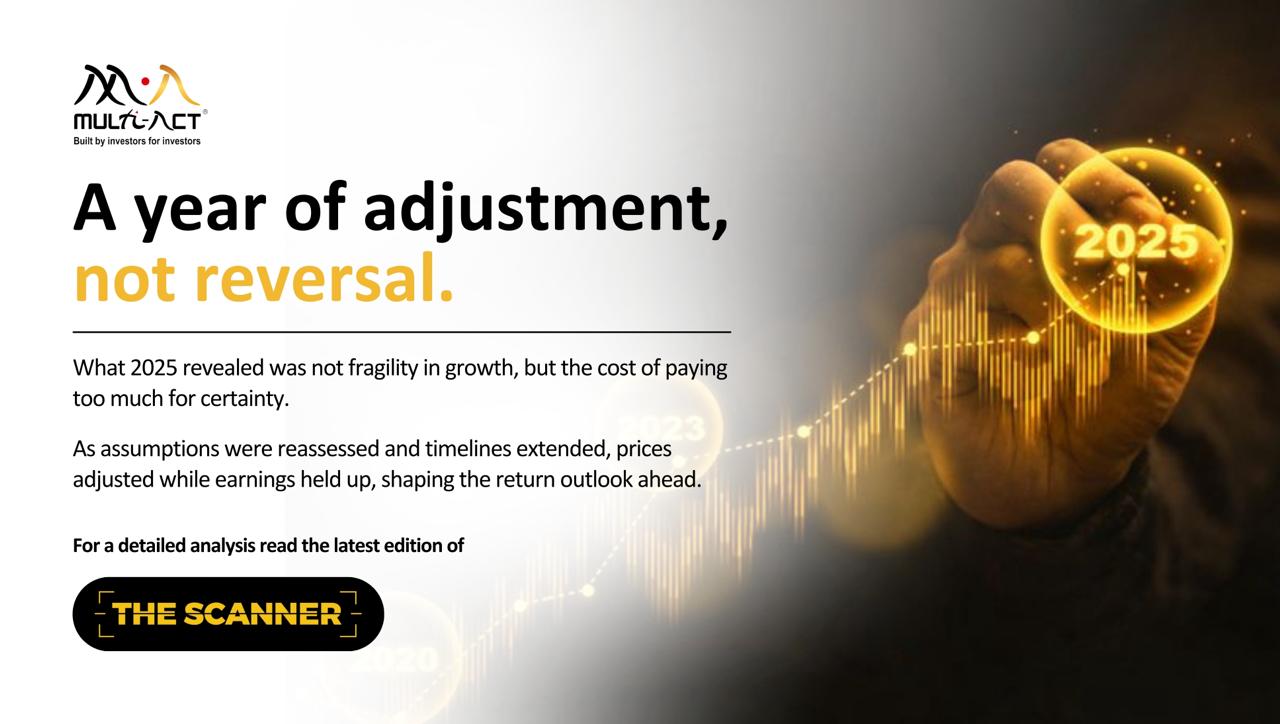
What Happened and What’s in Store for 2026
2025 did not challenge growth. It challenged assumptions. As expectations moved ahead of actual delivery, prices adjusted … Continued
Read more9 August 2017

“The stock market is the story of cycles and of the human behaviour that is responsible for overreactions in both directions.”– Seth Klarman.
When Warren Buffett famously stated that investing was simple but not easy, he meant that the rules we ought to use in order to make good investment decisions are easy to learn but actually adhering to them are difficult. Disregarding rules while investing cannot be attributed to open rebellion but can be ascribed to the basic human survival instincts that have been ingrained in us since time immemorial. Certain traits favoured in the process of Natural Selection and helped our ancestors survive in the jungle actually do not help in the market.
Fear is probably the biggest behavioural bias affecting investors. While the fear of approaching an unknown object or creature helped our ancestors to survive, today it limits the capacity of weighing probabilities and calculating risks in investment.
Confirmation bias occurs because humans by nature are social beings. Banding together has helped mankind survive through the ages. People tend to seek validation of their opinions from their peers. The shared opinion leads to a feeling of comfort while making a decision as it is a decision that is agreed upon by consensus. This does not work favourably for an investor in the market as it can often lead to the creation of bubbles in the market. Retail and sometimes non-retail investors tend to get into these cycles at their peak. Prime examples of how this ‘herd mentality’ has led to bubbles in the market can be seen in the cases of the tulip mania in 17th century Holland, the tech bubble in 2000 where just having the word “technology” in a company’s name meant that it entered the market at a high price or the global financial crisis when the housing bubble occurred as bankers and financiers assumed that property prices would always rise and never fall.
Behavioural biases could also occur due to bounded rationality. The concept that the cognitive limitations of one’s mind and the finite amount of time one has to make a decision is known as “bounded rationality”. If these limitations are not acknowledged, overconfidence in one’s abilities while carrying out complex tasks like investments will prevent one from reaching an optimal solution. The interaction of complexity of investment decisions and bounded rationality gives rise to several well-documented behavioural biases like overconfidence bias, the illusion of knowledge and the illusion of control.
John R. Nofsinger, while speaking about the overconfidence bias stated “Psychologists have determined that overconfidence causes people to overestimate their knowledge, underestimate risks, and exaggerate their ability to control events. Security selection is a difficult task. It is precisely this type of task at which people exhibit the greatest overconfidence.”
The illusion of knowledge occurs when an investor gathers information in the belief that more knowledge is equal to better decision making whilst not accounting for bounded rationality and the human brain’s linear processing powers. The illusion of control develops from an investor’s unwarranted belief in one’s ability to control outcomes by acquiring more information.
Following a set of rules can often be difficult as investors are mostly guided by cues from the external world like news coming through the papers, TV channels or simply by word of mouth. By accepting that behavioural biases are due to human fallacies, it is possible to develop methods to eradicate or minimize their effects in the investment decision-making process.
In order to ensure a rational, risk-controlled approach to investing, it is important that an investor follows an evidence-based approach. Basically, an investor should have a set of rules and the application of such rules should be based upon objective evidence.
John Bollinger coined the term “Rational Analysis”. The process of using different types of analyses has been likened to using multiple, specialised tools to complete a task. The rational approach is to use as many relevant tools that are at your disposal to complete a task effectively instead of just choosing one.
At Multi-Act, we have developed a system in-house called the Global Rational Analysis Framework (GRAF) based on the concept of Rational Analysis. It merges all four schools of investment analysis, namely fundamental, technical, quantitative and behavioural analyses. At Multi- Act, we use all these different tools while analysing a potential investment opportunity. And when most of these tools are saying the same thing, the possibility of making mistakes from a behavioural standpoint is reduced. This makes the investment process both simple and easy as the rules are well laid out. This system thereby allows us to focus on the main goals of the preservation of capital.
Multi-Act has a process in place to identify market sentiments of greed and fear and filter out the noise.
If we look at the example of Maruti Suzuki; the market was fearful of the labour clashes happening on the ground. The market was also wary of significant competition entering the small car segment. Our fundamental analysis suggested that Maruti continued to enjoy high relative market share wherein the second largest competitor had a market share half of that of Maruti. Maruti was available at a valuation at which we believe most of these negatives were already factored in while ignoring the strong fundamentals of the business. The GRAF framework helped us to not be affected by the noise and focus on the extremely favourable reward vs risk opportunity that was present at that point.
Equities by their very nature will continue to be volatile. As an investor, it is important to stick to your Investment processes and use the volatility to your advantage.

2025 did not challenge growth. It challenged assumptions. As expectations moved ahead of actual delivery, prices adjusted … Continued
Read more
Macro numbers alone rarely tell the full story. When jobs, consumption, credit, and inflation are considered together, … Continued
Read more
The AI story everyone sees is technological. The story that a few notice is financial. Revolving expenditures, … Continued
Read moreReceive monthly updates by signing up to our newsletter.
| Sr. No. | Received from | Pending at the end of last month | Received | Resolved* | Total Pending # | Pending complaints > 3 months | Average Resolution time^ (in days) |
|---|---|---|---|---|---|---|---|
| 1 | Directly from Investors | 0 | 0 | 0 | 0 | 0 | 0 |
| 2 | SEBI (SCORES) | 0 | 0 | 0 | 0 | 0 | 0 |
| 3 | Other Sources (if any) | 0 | 0 | 0 | 0 | 0 | 0 |
| Grand Total | 0 | 0 | 0 | 0 | 0 | 0 | |
Number of complaints received during month against the IA due to impersonation by some other entity: Nil
Note: In case of any complaints received against the IA due to impersonation of the IA by some other entity, the IA may adjust the number of such complaints from total number of received/resolved complaints while preparing the above table. Further, IA must close such impersonation related complaints after following the due process as specified by SEBI/ IAASB.
* Inclusive of complaints of previous months resolved in the current month.
# Inclusive of complaints pending as on the last day of the month.
^ Average Resolution time is the sum total of time taken to resolve each complaint in days, in the current month divided by total number of complaints resolved in the current month.
| Sr. No. | Month | Carried forward from previous month | Received | Resolved* | Pending# |
|---|---|---|---|---|---|
| 1 | April, 2025 | 0 | 0 | 0 | 0 |
| 2 | May, 2025 | 0 | 0 | 0 | 0 |
| 3 | June, 2025 | 0 | 0 | 0 | 0 |
| 4 | July, 2025 | 0 | 0 | 0 | 0 |
| 5 | August, 2025 | 0 | 0 | 0 | 0 |
| 6 | September, 2025 | 0 | 0 | 0 | 0 |
| 7 | October, 2025 | 0 | 0 | 0 | 0 |
| 8 | November, 2025 | 0 | 0 | 0 | 0 |
| 9 | December, 2025 | 0 | 0 | 0 | 0 |
| Grand Total | 0 | 0 | 0 | 0 | |
* Inclusive of complaints of previous months resolved in the current month.
# Inclusive of complaints pending as on the last day of the month.
| SN | Year | Carried forward from previous year | Received | Resolved* | Pending# |
|---|---|---|---|---|---|
| 1 | 2021-22 | 0 | 0 | 0 | 0 |
| 2 | 2022-23 | 0 | 0 | 0 | 0 |
| 3 | 2023-24 | 0 | 0 | 0 | 0 |
| 4 | 2024-25 | 0 | 0 | 0 | 0 |
| Grand Total | 0 | 0 | 0 | 0 | |
* Inclusive of complaints of previous years resolved in the current year.
# Inclusive of complaints pending as on the last day of the year.